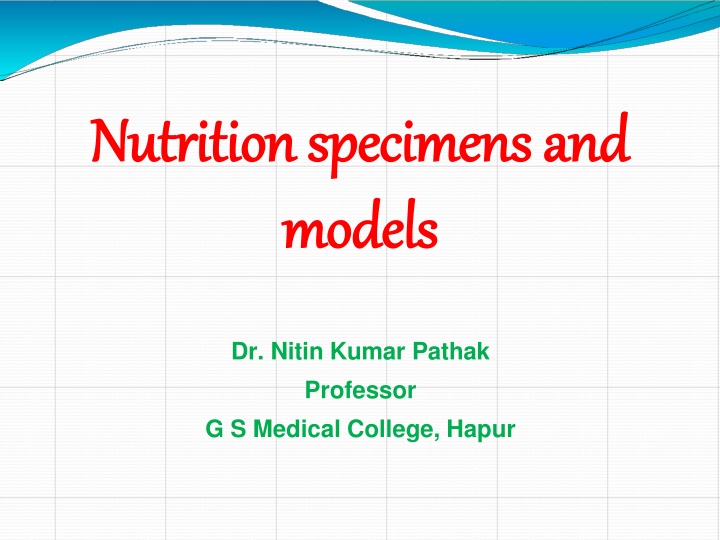
Nutrition: Essential Information for Health and Well-being
Dive into the world of nutrition with a comprehensive guide covering topics such as the science of food, nutrients, the importance of proper nutrition, types of nutrients, and the nutritive values of cereals. Explore how nutrition impacts human survival, growth, and overall health while learning about macro-nutrients, micro-nutrients, and the role of different food sources in maintaining a balanced diet.
Download Presentation

Please find below an Image/Link to download the presentation.
The content on the website is provided AS IS for your information and personal use only. It may not be sold, licensed, or shared on other websites without obtaining consent from the author. If you encounter any issues during the download, it is possible that the publisher has removed the file from their server.
You are allowed to download the files provided on this website for personal or commercial use, subject to the condition that they are used lawfully. All files are the property of their respective owners.
The content on the website is provided AS IS for your information and personal use only. It may not be sold, licensed, or shared on other websites without obtaining consent from the author.
E N D
Presentation Transcript
Nutrition specimens and Nutrition specimens and models models Dr. Nitin Kumar Pathak Professor G S Medical College, Hapur
Nutrition & dietetics Nutrition [Latin nutritic = nourishment]: The science of food and its relationship to health [ ..the process of intake, digestion and assimilation of nutrients the application ofthis knowledgetomaintain healthandcombatdisease ..]. Dietetics: .practical application of principlesof nutrition .. planning of meals ..
Food & nutrients Food:Food and Diet, on the other hand is what a person habitually eats and drinks. Nutrients: The nutrients are chemical substances that are presentinthefoodweeat. Eg. Carbohydrates, Proteins,Vitamins,etc. is a substance eaten or drunk to maintain life growth Eg. Cereals, Pulses, Vegetables, Meat, Milk, etc.
IMPORTANCE OF PROPER NUTRITION All living things need food and water tolive. All human beings need good food to livewell. Food = energy (measured incalories) Carbohydrates - 1 gram = 4calories Protein - 1 gram = 4calories Fats - 1 gram = 9calories Proper nutrition provides the body with the nutrients necessary to build, maintain, andrepair tissues.
Types of Nutrients Macro-Nutrients essential for human survival and growth. Indiandietcontributetothetotal energy intakeinproportionof- Carbohydrates 65-80% Proteins 7-15% Fats 10-30% Water Micro-Nutrients essential forgrowthand enhancethefunction and usability of macro-nutrients Vitamins Minerals The difference between macro and micro nutrients is the amount your need each day. Macro-nutrients must exceed one gram per day.
I. CEREALS Cereals are sources of Carbo, protein & fat. Constitute the bulk of diet Contribute 70-80% of total energy intake Eg. Rice, wheat, maize, corn, barley Limiting amino acids- Lysine.
Nutritive values of cereals/100gm Rice (milled) Wheat Maize (dry) Carbohydrate (gm) 78.2 71.2 66.2 Protein(gm) 6.8 11.81 11.1 Fat(gm) 0.5 1.5 3.6 Energy (kcal) 345 346 342
1. RICE:-Rice is a type of cereal and is staple food for South India. NUTRITIVE VALUE ( PER 100 g) Carbohydrates Fat Proteins B-complex : Thiamine 0.06 mg :Niacin - 1.9 mg :Riboflavin 0.06 mg : 0.6gms : 345kcal : Vitamins A, D & C PUBLIC HEALTH IMPORTANCE : Super ORS Milling process & washing in large quantities of water, discarding the water used for cooking deprives nutrients especially B-complex . : 80gms. : 0.5 gm : 6-7gms, rich in lysine. Minerals Energy DEFICIENT
PAR BOILED RICE Par boiling is the partial cooking of rice in steam. In par boiling technique, paddy is soaked in hot water (60-70 0C) for 4 hr. Water is drained, paddy is steamed for 10 min. Latter dried and milled. Processed rice products- Rice flakes & puffed rice Public health importance- Par boiling preserves the nutrients of brawn (deeper) layer (improves the nutritive value), improves keeping quality and insect resistance. Disadv- off flavour
Par boiling technique is recommended by CFTRI ( Central food technological research institute) Nutritive value / 100 gm Carbohydrate: 78gm Fat: 0.5gm Protein: 7.7 gm Energy: 345 kcal Adulterant used in rice:- Mud, grit & soapstone bits
2. WHEAT Bulk of wheat is consumed either as grains or flour or maida (white flour). The white the flour greater the loss of vitamins and minerals. So whole wheat flour is richer source of vitamin B than refined whiteflour. Protein content of wheat- Gluten (deficient in lycin). Uses- suji, bread. Processed products- bread, biscuits toast
NUTRITIVE VALUE (per 100 g) : Carbohydrates Fat Proteins Niacin Riboflavin Thiamine Minerals Energy DEFICIENT : Lysine and Threonine. PUBLIC HEALTH IMPORTANCE : Next to rice, wheat is most important staple diet in North India. It is a source of energy. : 70-71 g : : 5 mg. 0.17 mg 0.45 mg : : 1.5 g 12 g : : : 1.5 g 346 Kcal
3. MAIZE (corn, bhutta) The proteins of maize are deficient in tryptophan and lysine. Some strains contain excess leucine. Which interferes with conversion of tryptophan to niacin and this aggravates pellagrogenic action of maize. Chief protein- glutelin & zein Uses- cornflakes, custards & table deserts - food for cattle & poultry
II. MILLETS Major millets- Jowar & Bajra Minor millets / pseudicereals- Ragi, kodo
Nutritive values of Millets/100 gm Jowar (Sorghum) Bajra (Pearl millet) 68 Ragi Carbohydrate (gm) 72 72 Protein(gm) 10.4 11.6 7.3 Fat(gm) 1.9 5.0 1.3 Energy (kcal) 349 361 344
1. JOWAR (SORGHUM) It is a type of cereal and is staple food for Telangana and Marathwada. NUTRITIVE VALUE (PER 100 G) : Carbohydrates : 72 Proteins : 10 Fat: 1.9 Energy: 349 kcal B-Complex : Thiamine - 0.3mg Niacin - 3mg Riboflavin -1.3mg DEFICIENT : Lysine and Threonine. PUBLIC HEALTH IMPORTANCE : Jowar is rich in leucine. Excess of leucine interfere with conversion of tryptophan to niacin result in Pellagra. Prevention- Avoid total dependence on jowar Consumption of ground nut, which has niacin Aflotoxins- d/t improper storage (Aspergillus flavus inf.)
2.BAJRA (PEARLMILLET) Staple food of Rajastan, Gujarat and Maharashtra. NUTRITIVE VALUE (100Grams) Carbohydrates : 68 gm. Proteins : 10-14 gm. Energy 361 kcal : Calcium 42 mg. : 8 mg. Iron : DEFICIENT : Lysine and Threonine. PHI- Infestation of Bajra crop- Claviceps fusiformis (Ergot) Prevention- Floating them in 20% salt water, handpicking & air floatation
3.RAGI It is a popular millet in AP and Karnataka. It is cheapest among millets. It is rich in calcium & iron NUTRITIVE VALUE (PER 100 g): Calcium Protein Iron Carbohydrates : B-complex and vitamins in a small dose. Limiting AA- Lysine & Threonine PUBLIC HEALTH IMPORTANCE : 1. Weaning food 2. It is cooked and eaten as Porridge, Roti and halva. 3. Advised for diabetics & obese : 344 mg. (rich source) 7 gm 4 mg. 72 gm : :
III. PULSES AND LEGUMES Include a variety of Red gram, Bengal gram, Black gram, Green gram, Cow Khesaridhal, Peas, Beans including Soya beans. Limiting Amino Acid isMethionine. PUBLIC HEALTH IMPORTANCE : Pulses contain 20-25% proteins which is higher than that of Eggs, Fish, Flesh foods in quantity. But in quality pulse proteins are inferior to animal protein (Poor man s protein) Pulse proteins are rich in Lysine but deficiency in methionine and cysteine. They are rich source of B-complex vitamins and minerals Germinating pulses are also rich in Vit.C. gram, Horse gram,
1.SOYABEAN (QUEEN of all legumes) It is a type of pulse, high nutritive value. NUTRITIVE VALUE (PER 100 G) : Proteins : 40 gms Carbo- 20 gms Energy- 432 kcal Fat Minerals : 4 gms Calcium : 240 mg Iron : 10.4 mg DEFICIENT : Methionine. PUBLIC HEALTH IMPORTANCE : PEM It contains high proteins, Ca, Iron and Vitamins. It can be consumed as Dhal (or) mixing its powder with wheat flour. It can also be consumed in the form of soyabean milk, curd, baby foods. Source of linolenic & linoleic acid : 20 gms
GROUND NUT (Pea nut) King of nuts Nutritive value (per 100 g) Protein- 25gm Fat- 40 gm Rich source of protein, fat & energy among macronutrients Rich source of thiamine, nicotinic acid, ca, p, iron among micronutrients PHI- Most commonly used seed oil, MUFA (50%), low cast, high nutritive value It get infected with Aspergillus flavus, if not dried & stored properly-produces aflotoxins. Which is carcinogenic & hepatotoxic Carbohydrate-25gm Energy- 560 kcal
LOBIA / Black eyed peas : (Nutritive value / 100 gm) Carbohydrate-54.5 gm Protein-24.1gm Fat-1gm Energy-323 kcal Calcium-77 mg Iron-8.6 mg PHI- Lobia are cooked as dal in India and Pakistan. They help in toning of spleen and stomach plus high fibre content inside them helps in improvingdiabetes
RAJMAH / Kidney Beans: Nutritive value / 100 gm Carbohydrate-60.6 gm Protein-22.9gm Fat-1.3gm Energy-346 kcal Calcium-260 mg Iron-5.1 mg Limiting AA- Cysteine & methionine PHI- 1. Low in fat, high infiber. 2. Excellent levels of VitaminC. 3. Rich inprotein. 4. Cholesterol free. 5. Rich in omega-3 and omega-6 fattyacids. 6. Rich intheantioxidants likelutein, zeaxanthinand betacaroten
2. Bengal Gram (Chana) It is type of pulse. Nutritive value (per 100 g) : 17.1gm. Proteins : Fats Calcium Iron : Little amount of B-complex and Vit.C. : : 5.3 gm. 202 mg. 4.6 mg. PHI- Nutritive value can be increased by germination & fermentation.
3. Black Gram (Urd) It is type of pulse. Nutritive value (per 100 g) : Proteins : 24 gm. Fats : 1-2 gm. Calcium : 155 mg. Iron : 4 mg. Little amount of B-complex and Vit.C.
4. Red Gram (Tuvar/Arhar) It is type of pulse. Nutritive value (per 100 g) : Proteins : 22 gm. 1.7 gm. Fats : 73 mg. Calcium : 2.7 mg. Iron : Little amount of B-complex and Vit.C. PHI- Nutritional rehabilitation (75% ground nut flour & 25% roasted red gm flour) Food adulteration with khesari dal
5. KHESARI DHAL (LATHYRUS SATIVUS) Humans-neurolathyrism. Animals-osteolathyrism. spastic paralysis of lower limbs, occurring mostly in adults consuming the pulse, Lathyrus sativus in large quantities. Affected areas : M.P., U.P., Bihar and Orissa. Food adulterant- TOXINS- BOAA (Beta oxalyl amino alanine) Stages of diseases- Latent, No stick, 1stick, 2 stick, crawler Prevention- Vit.C prophylaxis, banning of crop, removal of toxins, parboiling
1. EGG Contains all nutrients except Vit.C and carb. NUTRITIVE VALUE (PER 60 Gm) : Protein : 6 gm. Fat : 6 gm. Calcium : 30 mg. Iron Little amount of minerals and trace elements. : 1.5 mg. Energy yielding : 70 kcal. NPU (Net Protein Utilization) : 100
PHI of EGG : It contains all the 9 essential amino acids. It contains all fat & water soluble vitamins (except Vit.C) Boiled egg is superior to raw egg. Because raw egg white is not assimilated by the intestinal mucosa. Boiling destroys avidin , a substance which prevents the body from obtaining biotin (B-complex vitamin). Salmonella can penetrate a cracked shell and enter the egg.
DISADVANTAGE : A reduction in egg intake is advised for those at risk of CHD because of the cholesterol content of egg is 250 mg./egg. But this should not be avoided by others from eating eggs.
BUTTER- It is rich in vit A (3200 micro gm/100 gm) &vit.D Nutrients/100 gm- Protein-nill Carboh- nill Fat-80 gm Energy-720 Kcal PHI- contains saturated fat-Atherogenic Excess consuption leads to dyslipidemia
GHEE- It contains 200 micro gm carotene/100 gm Nutrients/100 gm Protein-nill Carbohydrate- nill Fat-100 gm Energy-900 Kcal PHI- It contains saturated fatty acids which leads to the development of cardiovascular diseases. It is not advised in HTN, CVD, DM, Obesity. No other vitamins and minirals are present.
REFINED MUSTARDOIL It can be produced from black mustard (Brassica nigra), brown Indian mustard (Brassica juncea), and white mustard (Brassicahirta). Mustard Oil has about 60% MUFA& 21%PUFA . Advantages Of Mustard Oil Helpstostayawayfromcoronaryheartdiseases Itcan beusedasanantibacterialoil Useful for treating cough andcold
REFINED SOYABEANOIL It contains 61% PUFA and 24% MUFA (85% unsaturated fats) which is comparable to, or even betterthan mostvegetableoils Presence of Poly and monounsaturated fats reduces serum cholesterol levels, which makes people hearthealthy'. It also contains Omega 3 fatty acids, which help in the protection from heartdiseases
Nutritional Value of Curd /yogurt Nutrients/100gm Content Calories 61 Carbohydrates 4.7g Proteins 5.1g Total Fats 3.5g Minerals, vit,&electrolite
Health & nutrition benefits of eating yogurt/curd Consumption of curd - strengthening of the immune system. Thebacteria incurdcan helpdigestfood . Curd might help reduce the risk of high bloodpressure. Beneficial incaseof constipationandcoloncancer. Averygood snack forthosetrying toloseweight. Being rich incalcium,curd isgood forthebones & teeth Curd is effective in controllingdandruff. Curd is effective in lowering bloodpressure. Reduces bad cholesterol and lowers the risk of heart
CHEESE In addition to containing vitamins and quality proteins. Cheese is a very good source of calcium. It s a well-known fact that calcium helps build strong bones and helps fight againstosteoporosis. calcium-rich dairy foods can help you lose weight Each 100-gram portionof Cheesecontains 700 mg of calcium
Nutritive Value of Milk Buffalo 6.5 4.3 5.1 Cow 4.1 3.2 4.4 120 0.2 2 0.8 87 67 Human 3.4 1.1 7.4 28 0.3 3 0.1 88 65 Fat(g) Protein(g) Lactose(g) Calcium(mg) 210 Iron(mg) Vitamin C(mg) 1 Minerals(g) Water(g) Energy(kcal) 117 0.2 0.8 81.0
Diseases transmitted through milk tuberculosis, 1. 2. entericfever, 3. cholera, 4. dysentery and maltsfever. PHI- Milkadulteration
TH THA AN NK YOU! K YOU!




